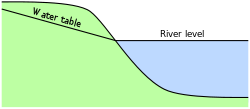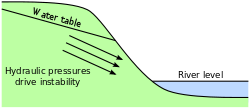- Landslide dam
-
A landslide dam, debris dam, or barrier lake is a natural damming of a river by some kind of mass wasting: landslide, debris flow, rock avalanche or volcano.[1] If it is caused by earthquake, it may also be called a quake lake. Some landslide dams are as high as the largest existing artificial dam. [2]
Contents
Causes
The major causes for landslide dams investigated by 1986 are landslides from excessive precipitation and earthquakes, which account for 84%. Volcanic eruptions account for a further 7% of dams. [3] Other causes of landslides account for the remaining 9%.
Consequences
The water impounded by a landslide dam may create a dam reservoir (lake) that may last from short times to several thousand years. [2]
Because of their rather loose nature and absence of controlled spillway, landslide dams frequently fail catastropically and lead to downstream flooding, often with high casualties. A common failure scenario is overflowing with subsequent dam breach and erosion by the overflow stream. [2]
Landslide dams are responsible for two types of flooding: backflooding (upstream flooding) upon creation and downstream flooding upon failure. Compared with catastrophic downflooding, relative slow backflooding typically presents little life hazard, but property damage can be substantial.
While the dam is being filled, the surrounding groundwater level rises. The dam failure may trigger further catastrophic processes. As the water level rapidly drops, the uncompensated groundwater hydraulic pressure may initiate additional landslides. Those that fall into the dam reservoir may lead to further catastrophic spillages. Moreover, the resulting flood may undercut the sides of the river valley to further produce landslides downstream. [2]
After forming, the dam leads to aggradation of the valley upstream, and dam failure leads to aggradation downstream.[2]
Construction engineers responsible for design of artificial dams and other structures in river valleys must take into account the potential of such events leading to abrupt changes in river's regimen.
Examples
- The highest known landslide dam of historic times is the Usoi Dam in modern Tajikistan created by a landslide triggered by an earthquake on February 18, 1911. It dammed the Murghab River to the height of 301 m (987 ft) to impound Sarez Lake 932 ft (284 m) deep.[2]
- Lake Waikaremoana in New Zealand was formed by a 250m high landslide dam believed to be 2,200 years old. Between 1935 and 1950 the landslide was tunneled and sealed to stabilise it so it could be used for hydroelectric power generation. This appears to be the first example of modification of a natural landslide for power generation.[4]
- Attabad Lake in Pakistan was formed by a landslide in 2010. (100m high)
- The "Red Lake" (Romanian: Lacul Roşu) is a barrier lake in the Eastern Carpathians chain in Harghita County, Romania. The name of "Lacul Roşu" comes from the reddish alluvia deposited in the lake by the Red Creek.
- The "Gros Ventre landslide" is an example of a huge, short-lived and disastrous landslide dam (60 m high).
- Quake Lake, created in Montana in 1959. (58m high)
- The Tangjiashan Lake, a dangerous "quake lake", was created as a result of the 2008 Sichuan earthquake. It was located in the extremely rugged terrain of Tangjiashan Mountain. Chinese engineers, scientists, and soldiers were involved in the digging of a sluice to alleviate the dangers of this one of 34 landslide dams created by the magnitude 8.0 Sichuan earthquake.[5] On June 10, 2008, the lake started to drain via the sluice, flooding the evacuated town of Beichuan.[6] (52m high)
- The Riñihuazo begun on 22 May 1960, after a landslide caused by the Great Chilean Earthquake blocked Riñihue Lake's outflow. According to the chronicler Mariño de Lobera a similar event occurred after the 1575 Valdivia earthquake. (26m high)
- Among the most destructive landslide lake outburst floods in recorded history occurred in the Sichuan province of China on 10 June 1786 when the dam on the Dadu River burst, causing a flood that extended 1400km downstream and killed 100,000 people.[7]
- The largest landslide dam in Britain impounds Tal-y-llyn Lake (Llyn Mwyngil) beside Cadair Idris in Snowdonia National Park, Wales. It was first recognised by E Watson in 1962. It is probably over 10,000 years old.
References
- ^ "Natural Debris Dams and Debris-Dam Lakes" (web). USGS/Cascades Volcano Observatory, Vancouver, Washington. 2003. http://vulcan.wr.usgs.gov/Glossary/DebrisDams/. Retrieved 2008-03-16.
- ^ a b c d e f Robert B. Jansen (1988) "Advanced Dam Engineering for Design, Construction, and Rehabilitation", ISBN 0-442-24397-9
- ^ R.B. Jansen refers to Schuster R.L. and Costa J.E., "A Perspective on Landlside Dams", in Landslide Dams by the American Society of Civil Engineers, 1986, pp. 1-20.
- ^ Offer, R.E. (Robert) (1997). Walls for Water: Pioneer Dam Building in New Zealand. Palmerston North: The Dunmore Press Ltd.. ISBN 0-86469-313-3.
- ^ Amid race to drain Chinese quake lake, emergency plans proceed_English_Xinhua
- ^ Flooding spreads more destruction in town below 'quake lake' - International Herald Tribune
- ^ Schuster, R.L. and G. F. Wieczorek, "Landslide triggers and types" in Landslides: Proceedings of the First European Conference on Landslides 2002 A.A. Balkema Publishers. p.66
Categories:- Dams
- Landslides
Wikimedia Foundation. 2010.


